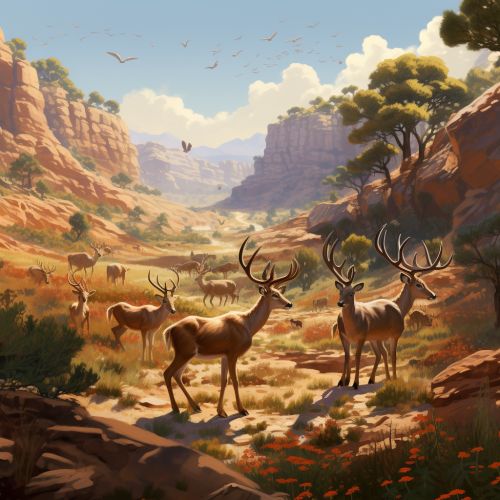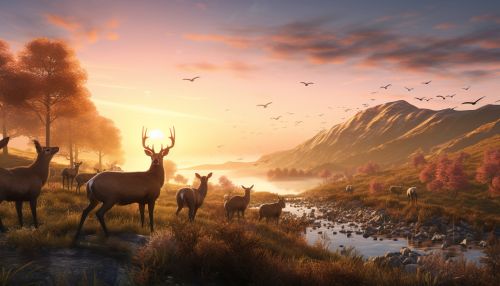Mammal Migration
Introduction
Mammal migration refers to the seasonal movement of mammals from one habitat to another. This phenomenon is a crucial survival strategy for many species, allowing them to exploit resources, reproduce, and avoid unfavorable conditions. Mammal migration is a complex process, influenced by various environmental, physiological, and genetic factors.
Types of Mammal Migration
There are several types of mammal migration, each characterized by unique patterns and triggers.
Seasonal Migration
Seasonal migration is the most common type of mammal migration. Mammals move from one habitat to another in response to seasonal changes in food availability, weather conditions, or breeding opportunities.
Altitudinal Migration
Altitudinal migration involves movement up and down mountains or hillsides with the changing seasons. This type of migration is common among mountain-dwelling species, such as the American pika and the snow leopard.
Nomadic Migration
Nomadic migration is a less predictable form of migration, where mammals move in response to irregular changes in food or water availability. This type of migration is common among desert-dwelling species, such as the African elephant and the dromedary camel.
Factors Influencing Mammal Migration
Several factors influence mammal migration, including environmental cues, physiological triggers, and genetic predispositions.
Environmental Cues
Environmental cues, such as changes in temperature, day length, and food availability, can trigger mammal migration. For example, the migration of the Arctic tern is triggered by changes in day length, while the migration of the monarch butterfly is triggered by changes in temperature.
Physiological Triggers
Physiological triggers, such as changes in body condition or reproductive status, can also initiate mammal migration. For example, the migration of the gray whale is triggered by changes in body condition, while the migration of the caribou is triggered by changes in reproductive status.
Genetic Predispositions
Genetic predispositions can also influence mammal migration. Some species, such as the salmon, have a strong genetic predisposition to return to their birthplace to reproduce, a behavior known as homing.
Impacts of Mammal Migration
Mammal migration has significant impacts on ecosystems, influencing biodiversity, nutrient cycling, and food web dynamics.
Biodiversity
Mammal migration can enhance biodiversity by promoting species interactions and facilitating gene flow. For example, the migration of the wildebeest in the Serengeti promotes interactions with predators, scavengers, and other herbivores, enhancing biodiversity.
Nutrient Cycling
Mammal migration can also influence nutrient cycling. Migrating mammals transport nutrients from one habitat to another, contributing to nutrient cycling. For example, the migration of the salmon transports nutrients from the ocean to freshwater ecosystems, enhancing nutrient cycling.
Food Web Dynamics
Mammal migration can influence food web dynamics by altering the availability of prey for predators and the competition for resources among species. For example, the migration of the caribou in the Arctic influences the availability of prey for predators, such as wolves and bears, and the competition for resources among other herbivores.
Threats to Mammal Migration
Mammal migration faces several threats, including habitat loss, climate change, and human disturbance.
Habitat Loss
Habitat loss due to deforestation, urbanization, and agricultural expansion is a major threat to mammal migration. It can disrupt migration routes, reduce the availability of resources, and increase the risk of predation.
Climate Change
Climate change can also threaten mammal migration by altering environmental cues, changing the distribution of resources, and increasing the frequency and intensity of extreme weather events.
Human Disturbance
Human disturbance, such as noise pollution, light pollution, and recreational activities, can disrupt mammal migration. It can alter migration routes, disturb resting and feeding sites, and increase the risk of collision with vehicles and structures.
Conservation of Mammal Migration
Conservation of mammal migration is crucial for maintaining biodiversity, ecosystem functioning, and the provision of ecosystem services. It involves protecting migration routes, mitigating threats, and promoting sustainable practices.
Protecting Migration Routes
Protecting migration routes, also known as corridors, is a key conservation strategy. It involves establishing protected areas, restoring degraded habitats, and creating wildlife crossings.
Mitigating Threats
Mitigating threats to mammal migration involves reducing habitat loss, mitigating climate change, and minimizing human disturbance. This can be achieved through land use planning, climate change mitigation strategies, and public education.
Promoting Sustainable Practices
Promoting sustainable practices, such as sustainable agriculture, forestry, and tourism, can also contribute to the conservation of mammal migration. These practices can reduce habitat loss, minimize human disturbance, and promote coexistence between humans and wildlife.
See Also


